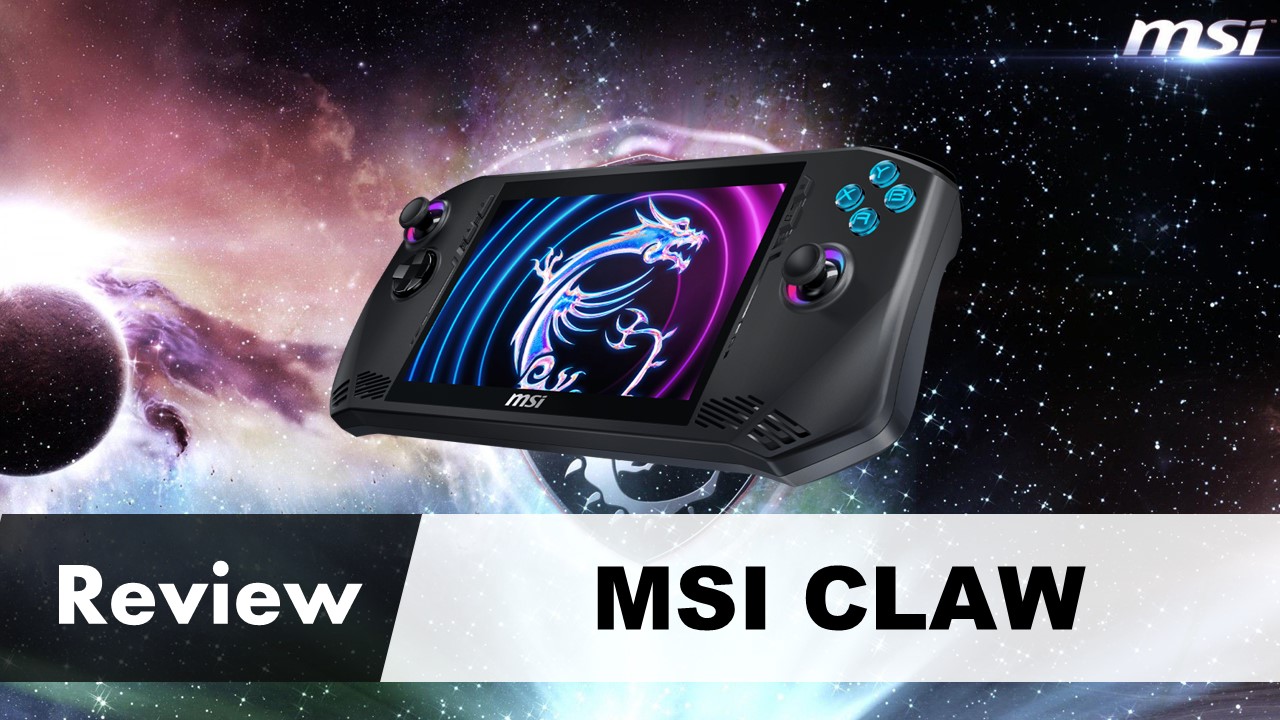The MSI Claw has good productivity performance and a comfortable grip, but there are software problems, and design flaws, and it doesn’t perform as well for gaming. You can find something better for less money.
Pros
- Comfortable grip
- Strong Intel performance
- Powerful speakers
- Thunderbolt 4 connectivity
Cons
- Weak gaming performance
- Low-quality bumpers
- Gets excessively hot
- Software problems
- Battery life could improve
At CES 2024, I had the chance to try out the MSI Claw for the first time. Despite encountering some problems during my test, I remained optimistic that these issues would be addressed before its official release. Being a fan of Windows gaming handhelds since the Asus ROG Ally, I’ve eagerly anticipated getting my hands on the Claw ever since it was unveiled late last year.
Although I appreciate other Windows 11 handhelds such as the Asus ROG Ally and Lenovo Legion Go, I’ve noticed that Microsoft’s operating system and the launchers on these devices don’t offer the same smooth experience as SteamOS does on the Steam Deck. When I first heard about the Meteor Lake-powered MSI Claw, I was hopeful for the future of Windows 11 handhelds. However, it’s disappointing to see that the experience hasn’t matched the initial excitement.
There are things I like about it, like how comfortable it is to hold, how smoothly it runs without making much noise, and its vibrant 1080p 120Hz display. However, I’ve been let down by the overall experience. And the biggest problem is software.
However, the Claw’s launch fell short of expectations, revealing a slew of issues that place it several steps behind its competitors. I had high hopes that MSI could dethrone the reigning champions of handheld gaming devices, but unfortunately, it has only managed to disappoint.
Technical Specifications of MSI Claw
| Feature | Specifications |
| Price: | $699.97 to $799.94 |
| Display: | 120Hz refresh rate, IPS display 1920 x 1080 |
| CPU: | Core Ultra 7 155H by Intel |
| RAM: | 16GB |
| Storage: | 1TB |
| Battery: | 6 hours and 06 minutes (1 hour and 24 minutes in gameplay) |
| Dimensions: | 11.6 x 4.6 x 0.85 inches |
| Weight: | 1.47 lbs |
Pricing And Configuration of MSI Claw
The pricing of the MSI Claw is somewhat peculiar, as it stands out as the priciest option among Windows gaming handheld devices. The Asus ROG Ally offers configurations ranging from $599 to $699 (often discounted by $100-$200), The Lenovo Legion Go ranges from $699 to $749. At the same time, our reviewed version of the Claw, priced at $799, is the priciest option. It comes equipped with an Intel Core Ultra 7 155H processor and 1TB of SSD storage and is available for purchase on MSI’s website.
The Claw starts at the same price as the Lenovo, beginning at $699 with an Intel Core Ultra 5 125U processor and 512GB of SSD storage. Positioned in the middle is a $749 model equipped with the same Ultra 7 processor but with 512GB of storage.
While a higher price tag isn’t necessarily a dealbreaker, it does require the Claw to work harder to justify its cost. Its rivals offer more budget-friendly options, making its shortcomings all the more disappointing. In addition to its processor and storage, the MSI Claw boasts 16GB of RAM, a 7-inch IPS display with a resolution of 1920 x 1080 pixels and a refresh rate of 120Hz, as well as Windows 11 Home.
Design and Built
The MSI Claw gets its name from its ergonomic design, which is crucial for gaming, especially during long sessions. Comfort is key when holding a device for extended periods, and the Claw excels in this aspect with its innovative feature: two controller-like grips located at the back.
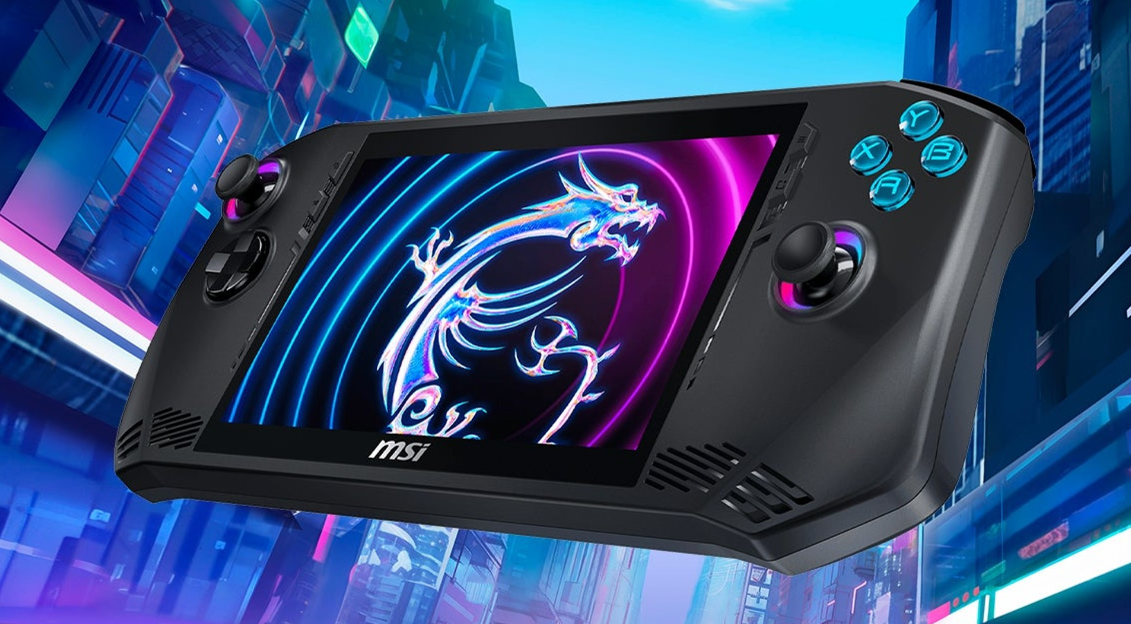
I maintained a firm hold on the device, aided by the gentle curves flanking each side that offered support for my fingers. Unlike the Ally, which would sometimes cause numbness in my arms after extended use, I didn’t feel the need to support the bottom of the Claw with my pinkies, despite it being heavier. Although both devices feature controller grips, the claws are more prominent, allowing me to hold onto them securely without requiring additional support.
In other aspects, the design of the Claw closely resembles that of the ROG Ally, featuring face buttons, a D-Pad, and joysticks laid out in the same configuration as a typical Xbox gamepad. Contrasts include its black finish and rear triggers equipped with Hall Effect sensors, eliminating the need for physical contact to register input. However, due to its design, the buttons on the Claw are difficult to see in low light conditions, as they blend in with the dark engravings.
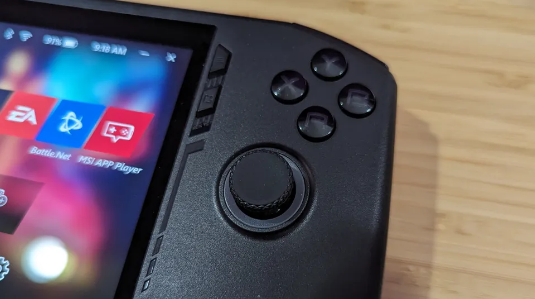
The two Macro Key buttons, located at the back for recording keys, are positioned too closely to each grip on the Claw. I found myself accidentally clicking them while playing Dark Souls. While the Claw’s curved bumpers are innovative, I prefer a more traditional straight bumper design. Additionally, the bumpers have a noticeable squishiness rather than a satisfying click when pressed. Furthermore, the clickable portion of the bumpers does not fully extend through, preventing it from being pressed down at the edge closest to the center of the device. This issue mirrors a criticism I had with Xbox One controllers, which is why I avoided using them.
The MSI Claw falls in the middle range in terms of weight and size compared to other handheld gaming devices, measuring at 11.6 x 4.6 x 0.85 inches and weighing 1.47 lbs. The Asus ROG Ally (11.02 x 4.37 x 0.83-1.28 inches, 1.35 lbs) is lighter and smaller, while the Lenovo Legion Go (11.8 x 5.15 x 1.61 inches, 1.8 lbs) is notably larger and heavier.
Ports and Connectivity
The Claw comes with the typical assortment of ports you’d expect for a gameplay handheld, including a microSD slot, a 3.5mm audio jack, and a power button equipped with a fingerprint sensor. However, it catches us off guard with its Thunderbolt 4 integration.
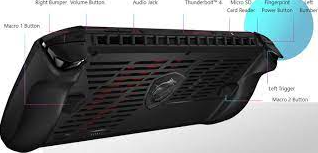
The Ally shares similarities, but it includes a USB-C 3.2 Gen2 port, while the Legion Go boasts two USB-C 4.0 ports. However, neither device offers Thunderbolt 4 support. What sets the Claw apart is its inclusion of Wi-Fi 7, making it unique among gaming handhelds.
The Display of MSI Claw
The Claw features an IPS touchscreen 120Hz refresh rate panel with 1920 x 1080-pixel resolution. While this specification is fairly typical for a gameplay handheld, it’s reassuring to know that it’s not limited to a 720p display.
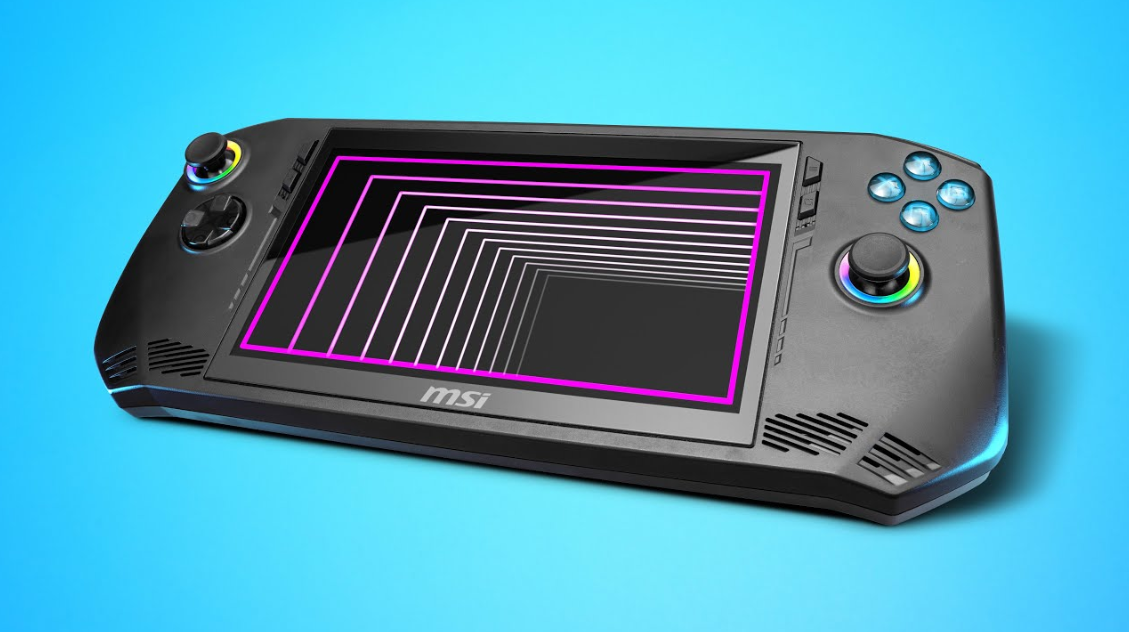
I started Dark Souls and ventured through a dark cave, captivated by its striking combination of Gothic architecture and immersed in the darkness of the cave. The display effectively showcased the vibrant colors of fires in the environment against the constant red backdrop, but it’s worth noting that this machine isn’t exceptionally colorful. Especially when compared to my experiences testing the game on OLED displays, it leaves me hoping that future models of Windows handheld gaming devices will feature OLED panels. However, the screen did reach a sufficient level of brightness to allow for gameplay in brightly lit rooms.
The Claw scored below average on our color tests, only reproducing 72.4% of the DCI-P3 color gamut. As expected, it falls short of the mainstream gaming average of 91%. Additionally, it performs worse than the ROG Ally (76.6%), while the Legion Go (107.4%) outshines it in terms of vividness.
In our brightness tests, the Claw performed well, reaching an average peak of 428 nits, which surpasses the mainstream gaming average of 377 nits. However, it falls short compared to the Asus ROG Ally (464 nits) and the Legion Go (478 nits).
Read Also: Lenovo Legion Go: Handheld Gaming Console with Ryzen Z1 and 144Hz Display
Audio
Having quality audio in a handheld device is crucial, as a subpar speaker system can detract from the gaming experience and necessitate the use of headphones. I find that to be quite inconvenient. However, I can confirm that the Claw’s speaker system provides solid sound for mobile gaming. This is an area where the device excels compared to the ROG Ally. The Claw’s speakers are noticeably louder and more powerful.
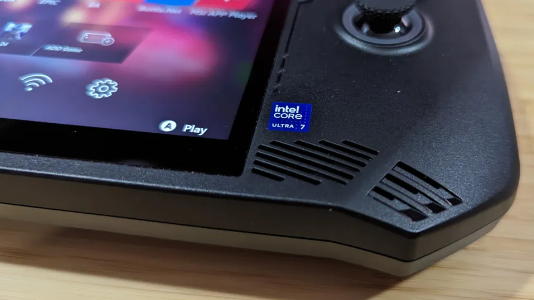
As I played Dark Souls, I was struck by how the menu music resonated through my fingertips, sending shivers down my spine as I delved into the game and navigated the enemies in the dark caves by their footstep sound. The flame of the fire burning on the walls sounded clear and satisfying, while the eerie drone of the atmospheric soundtrack added to the immersive experience.
Graphics and Gaming
The MSI Claw stands out among Windows gaming handhelds for its unique features. Unlike the Ally and Legion Go, it utilizes an Intel processor instead of AMD. It comes equipped with the latest Meteor Lake CPUs, with the base model featuring an Intel Core Ultra 5 125U CPU and the higher-end model boasting an Intel Ultra 7 155H. Additionally, it comes with 16GB of RAM and offers either 512GB or 1TB of SSD storage.
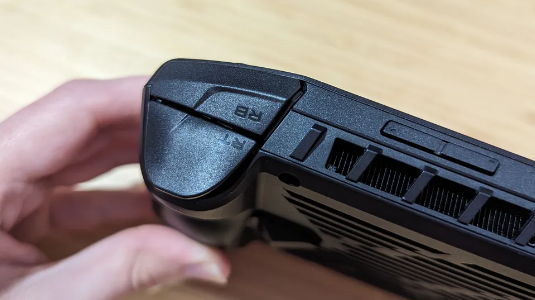
When I played Call of Duty with the graphics set to high on the Claw, the performance was too choppy to enjoy. So, I switched everything to low at 1080p resolution. This kept the frame rate around 33 fps, but I still experienced frequent stutters, freezes, and slowdowns, sometimes dropping as low as 21 fps. Interestingly, disconnecting the device caused the frame rate to drop even further, averaging between 19 to 23 frames rate often experiencing increased instances of slowdowns. While this might seem acceptable for a lightweight gaming PC, the ROG Ally (AMD Ryzen Z1 Extreme) maintained a much smoother experience, running Call of Duty at 1080p with high graphics settings at a consistent 51 to 62 fps.
I also attempted to run Asphalt, but it wasn’t stable enough to access the graphics settings and make changes, in addition to the control issues I encountered. Moving the camera caused the game to freeze, and when it was in motion, the frame rate dropped below 11 fps.
The Claw will leverage Intel XeSS technology to enhance frame rates in certain games by employing AI upscaling. This encompasses a wide range of over 50 titles, such as Gran Turismo 7, Days Gone, Call of Duty Warfare, and numerous others.
We conducted multiple gaming tests on the Claw but encountered some challenges. It couldn’t handle running our usual choice of games at their maximum graphics settings. However, we managed to get it to run Asphalt.
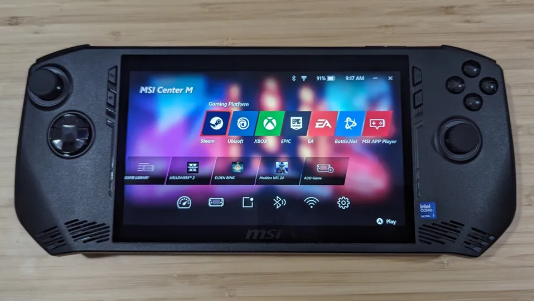
During the Asphalt checking on the heavy resolution setting at 1080p, the device averaged 22 fps Surprisingly, it competes for the performance of the Asus ROG Ally, which is unexpected considering Ally’s superior performance in many other games.
Otherwise, these tests are independent and cannot be directly compared to other devices due to variations in graphic settings. Call of Duty firing achieved 48 fps at 720p on medium graphic settings, while Asphalt ran at 28 fps on Ultra settings at 1080p. However, Alane Wake 2 maintained a steady 31 fps with Doom Eternal set to Medium at 1080p.
Performance of MSI Claw
The MSI Claw is equipped with a Core Ultra processor by Intel, SSD storage of 1TB, and RAM of 16 GB. On broadside, this configuration should deliver outstanding performance compared to AMD competitors. However, the actual results might be surprising.
On the Geekbench 6.3 overall performance test, the Claw achieved a multi-core score of 10,108, surpassing the mainstream gaming laptop average of 8,374. However, the Asus ROG Ally with its AMD Ryzen Z1 Extreme CPU scored higher at 11,052, while the Legion Go with the same CPU fell behind at 9,631.
When converting a 4K video into 1080p using the VideoLan app, the Claw completed the task in 6 minutes and 23 seconds, which is slower than the average of 4 minutes and 32 seconds. Once again, the Asus ROG Ally takes the lead with a time of 4 minutes and 54 seconds, while the Legion Go is significantly slower at 9 minutes and 21 seconds.
The Claw copied 30GB of multimedia files in 35 seconds at a transfer rate of 916 megabytes per second, which falls short of the category average of 1,462MBps. The Asus ROG Ally with a 512GB SSD performed the poorest, achieving a transfer rate of 764MBps. On the other hand, the Legion Go with a 1TB SSD claimed the top spot, coming closest to the average with a transfer rate of 1,422MBps.
Read Also: Introducing the Razer Kishi: Mobile Gaming Elevated to New Heights
Software of MSI Claw
Any top-notch gaming handheld requires exceptional software support. Windows can be cumbersome to navigate with a gamepad, and having a dedicated app to organize your game library is essential. The Claw addresses this challenge with the MSI Center M application, which automatically updates installed games, provides shortcuts to game launchers, and offers extensive settings for the Claw.
MSI Center M excels with its game bar feature, which automatically includes crucial launchers such as Xbox App, Ubisoft Connect, Steam, Epic Games, EA Play, and Battle.net. This makes it easy to access these applications, potentially reducing the need to rely heavily on Windows 11.
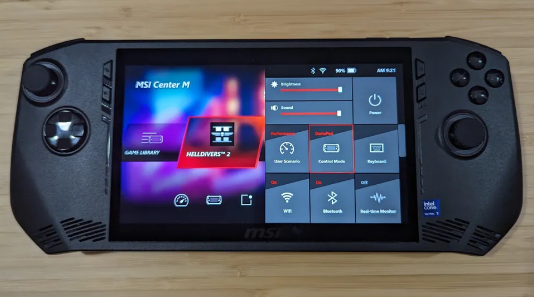
The Claw is equipped with a Quick Settings button designed for convenient access to vital settings such as performance and control modes. Though, dissimilar the ROG Ally’s intelligent Auto feature, which automatically detects the required mode, the Claw provides only two options: GamePad and Desktop. Nonetheless, MSI Center M is fully customizable, offering useful shortcuts like displaying a digital keyboard or returning to the desktop.
However, MSI Center M has its fair share of bugs. When I launched Call of Duty, I couldn’t navigate through the menus until I realized I was still in Desktop mode. Pressing the Quick Settings button to switch modes, I found that clicking on the option to change from desktop to gamepad mode would exit the tab. I had to tap on it manually to switch modes. Once I entered the game in gamepad mode, I attempted to adjust other settings in the Quick Settings menu but encountered a shadow cursor hovering over the Performance setting. Whenever I selected a setting, it would inadvertently activate where the ghostly cursor appeared on the screen.
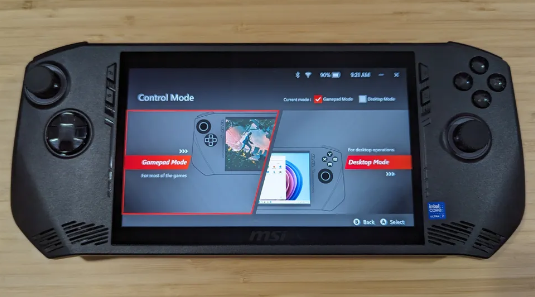
To ensure that desktop operations function properly, you need to navigate to the MSI Center M, select Control Mode at the bottom, open Desktop Mode, and switch from Macro Keys to Combination keys. Otherwise, you’ll be unable to utilize crucial shortcuts such as raising the keyboard to type, capturing screenshots, or swiftly returning to the desktop.
Since the default shortcuts for returning to the desktop and performing other useful tasks are disabled by default (The system prioritizes possible Macros), you may find yourself trapped when nothing is working properly. I simply swiped up on the bottom of the screen haphazardly until I was able to exit the game when it froze.
Moreover, the MSI Claw offers a media gallery for storing images and videos, Macro Key recording functionality, AI-driven battery conservation, and an MSI App Player for convenient access to Android apps.
Battery Life Of MSI Claw
MSI boasts that the Claw can endure two hours of gaming at full throttle with its 53Whr battery. This gives it an edge over the Ally and Legion Go, which have 40Whr and 49.2Whr batteries, making the Claw the frontrunner on paper.
Yet, gauging battery longevity isn’t as simple. The Intel Meteor Lake processor series poses a distinct hurdle when contrasted with the AMD Ryzen Z1 Extreme found in the Ally and Legion Go. The spotlight falls on MSI: does the company truly deliver on its promises?
On theTechBasic battery test, which entails continuous web browsing over Wi-Fi at 152 nits, the Claw endured for 6 hours and 4 minutes. This exceeds the category average of 5 hours and 29 minutes. It also outperformed the Asus ROG Ally (5:53) and Legion Go (4:08).
However, the crucial factor is how long these devices can sustain gaming sessions, and unfortunately, the Claw falls short at 1 hour and 24 minutes, despite MSI’s two-hour promise. The ROG Ally (1:44) and Legion Go (1:54) managed to last a bit longer, approaching the two-hour mark.
Accessories
The only available Claw outlying at present is the Nest Docking Station, priced at $79, although it appears to be out of stock currently. While we haven’t had the opportunity to test the finalized model, we did get hands-on experience with a prototype at CES 2024. By clicking its front panel and sliding it out, users can place the handheld device in the dock, granting access to additional ports. The prototype model we examined included an HDMI port, three USB-C ports, two USB-A ports, and an Ethernet port.
Heating
When it came to assessing heat levels, we took a different approach with the Claw, given its unique design. Following a 20-minute video streaming session, our analysis revealed that the left directional D-Pad registered a temperature of 87.4 degrees Fahrenheit, with the underside measuring 84 degrees. The hottest spot, hitting 92 degrees, was identified at the center of the top edge. After a subsequent 20-minute gaming session, heat levels experienced a slight increase. While the directional D-Pad maintained a relatively cool temperature of 84 degrees, the underside warmed up to 91 degrees, and the center of the top edge peaked at 103 degrees.
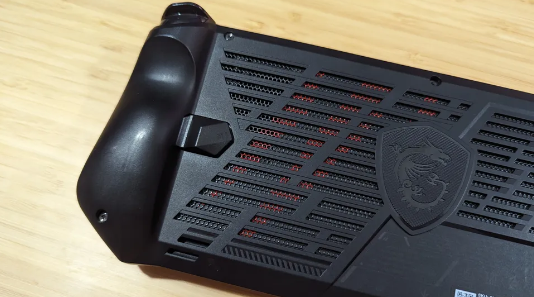
While heat specifications may seem important, the true test is how it feels when you’re holding it, and unfortunately, the Claw doesn’t provide a pleasant experience in that regard. If you keep your fingers on the grips and don’t stray much beyond them, you’ll notice only a slight warmth. However, if you rest your fingers against the back plate, it becomes uncomfortably hot.
I’ve spent countless hours gaming on my ROG Ally without experiencing any discomfort from heat, but this issue was immediately noticeable when I switched to the Claw. The main issue is that the vents are located on the lower part of the backplate, causing your fingers to feel the heat when resting. This even makes the grips feel somewhat steamy.
Conclusion
The Claw is a total disaster. Even if you’re willing to overlook its software glitches, design flaws, and uncomfortable heat levels, it’s hard to ignore that it comes with the highest price tag among Windows gaming handheld devices ($799), yet delivers the worst performance by a significant margin.
I was astonished to witness the drastic difference in performance while playing Call of Duty on the MSI Claw. Despite lowering the graphical settings significantly, the game ran at nearly half the framerate compared to the less expensive Ally. That should speak volumes. The Claw represents a disappointing failure for MSI, and I would suggest exploring alternatives like the Lenovo Legion Go or Asus ROG Ally for a more satisfying gaming experience.

